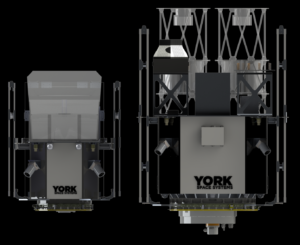Dirk Wallinger, CEO of the Denver-based manufacturer, said it has already secured several customers for the more powerful platform, with the first in the fleet launching in 2022.
“We’ve seen interest in a larger platform with more capabilities from both our government and commercial customers, and the LX-CLASS is suited for both segments,” Wallinger told SpaceNews.
LX-CLASS will reuse over 90% of the S-CLASS design, reducing schedule and cost risk for missions ranging from communications to Earth observation.
It will also include cybersecurity and encryption systems developed for military customers on the S-CLASS.
“A lot of our customers are realizing that it’s incredibly time intensive and expensive to continue to try and engineer components to fit on smaller spacecraft,” Wallinger said.
“With the LX-CLASS we are offering a solution that provides them with more flexibility in terms of payload capability, while also ensuring a delivery cadence that is unrivaled in the sector. York is able to leverage a strong U.S. supply chain to ensure our military customers are getting the security they demand with a proven system.”
He said the company is currently building 15 under-contract spacecraft in a facility designed to produce 20 simultaneously. The number of S-CLASS under production is “well exceeding 10, and the LX-CLASS [is] ramping production throughout this year.”
Because the platforms share more than 90% of components and systems, York can scale and shift production between them based on market demand.
“Customers of both platforms benefit from a quality, risk, schedule, and cost standpoint because of how we approach production,” Wallinger said.
“As a result, we are agnostic to how the proportion of sales may vary between the platforms.”
In October 2019, before the COVID-19 pandemic disrupted supply chains and businesses around the world, York had plans to produce 50 satellites in 2020 — and hundreds annually in the future.
Wallinger said demand is continuing to align with its previous expectations.
“Demand for larger platforms is based on an increase in demand as opposed to a shift,” he noted.
“They aren’t necessarily mutually exclusive.”
Lithuanian nanosatellite maker NanoAvionics announced plans March 23 to build larger microsatellites, expanding from buses in the 12- to 35-kilogram range to 50 kilograms or more.
Vytenis Buzas, CEO of NanoAvionics, said increasingly affordable and available satellite launch services are helping shift industry focus away from the smaller end of the small satellite market.
York’s LX-CLASS will also feature the same autonomous operations capability used by the S-CLASS, which enabled the company to reduce the number of people needed to operate a constellation for a specific customer from 15 to zero.
In August, the Pentagon’s Space Development Agency awarded York a $94 million contract to partly build a network of satellites in low Earth orbit for the military.
York and Lockheed Martin are building 10 satellites each for the Space Development Agency’s Transport Layer Tranche 0 mesh network, slated to launch in 2022.



